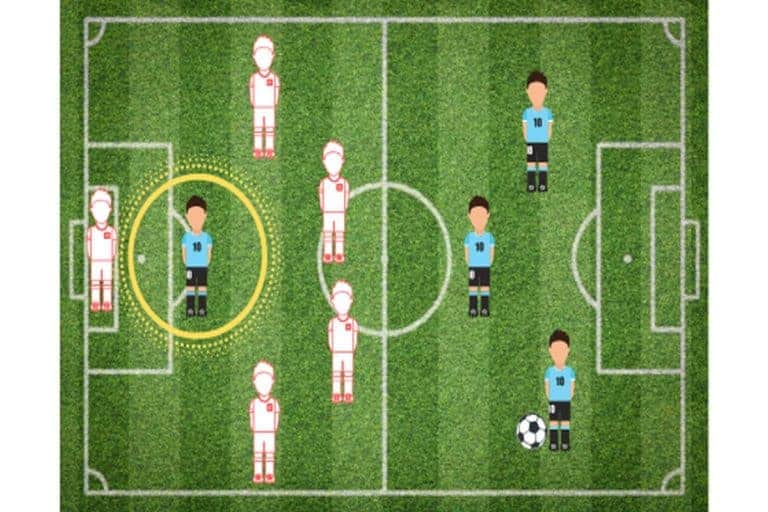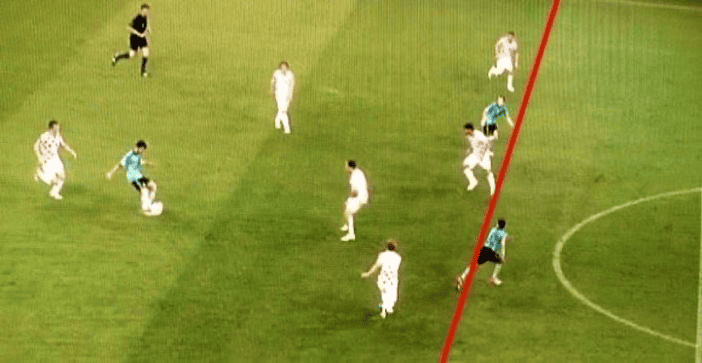Ever heard of an offside in soccer? The rules of offside are one of the most complex guidelines in the game. It heavily guides your head, body, and feet’s position and your distance to the ball and the opponent.
Don’t worry! I will further explain in this article how it works so you can be more mindful in your next soccer game.
Can You Be Offside on a Throw-in?
You can be in an offside position during a throw-in. There are no rules that state that you’re not allowed to be in an off-side position at this moment.
Furthermore, an offside player is allowed to receive the ball directly from a teammate through a goal kick, a throw-in, a corner kick, or through their opponent who deliberately passed the ball (meaning the offside player has no control over the ball’s movement or game).
Why Are There No Offsides on a Throw-in?
Offsides are not applied to throw-ins. Why, you ask? Simply because it would limit the team to benefit from a throw-in.
With offside rules, the defending player on the offside would have an offense if he does something with the ball, like kicking it forward towards its goal.
How Does Being in an Offside Position Affect a Player at a Throw-in?
Being in an offside position lessens the power of the player (on offside) to be more active in play. Before I further explain, let me run through how a player is identified to be in an off-side position through the photo below.

According to Law 11, a player is in an offside position if any part of their head, body, or feet is closer to the opponent’s goal line, rather than the ball and the second last opponent (the second player standing there from the opponent team after the goalkeeper).
Being in an offside position doesn’t automatically make you an offside. As long as you’re not getting in the way of the play, you’re safe from the offense. Being in an offside position limits you from participating in active play or gaining an advantage over the ball.
This limits the off-side player’s involvement in the game. The only way for them not to be penalized is either by directly receiving a ball from a goal kick, corner kick, or throw-in.
When you’re in an offside position, a throw-in can be your saving grace. The opponent cannot have an offside offense this way since the ball came directly from another player in their team.
However, the moment the opposing team touches the ball, the offside rule will resume again. It is important for you to know this to avoid further offense of playing with the ball after it is touched by an opponent from the throw-in.
Can You Be Offside If the Ball Comes Off a Defender?
You cannot be offside if the ball comes off a defender. If, by any chance, you’re in an offside position and the defender deliberately lets go of the ball due to poor kick and the ball goes to you, you won’t be offside.
By deliberately, it means that the opponent loses control over the ball due to a poor attack, leading it to land towards a player’s position.
To not be counted as an offside, the player in the offside position should not, in any way, gain control over the movement of the ball. It should come to him or her directly, without any manipulation from his or her own actions.
You can be offside, though, if you interfere with the opponent’s team from scoring, for instance, by kicking the goal.
For example, if it’s clear that the direction of the goal was kicked and is heading towards the goal, you can explicitly kick the ball in the other direction to keep it from scoring.
This law became quite controversial with some games, as there really needs to be more clarity on what a deliberately poor kick looks like.
For more clarity, watch Offside controversy in Atlanta, as this is an example of a controversial offside ruling.
As you can see, the defending team’s player was attempting to pass it to a teammate but accidentally passed it on to the opponent, who deliberately kicked the ball to go to their teammate but was thrown into the defense player in an offside position.
The defender defended the ball from the opponents and kicked it towards the goal. However, instead of scoring, it became an offside. It was seen that the ball was headed toward the defense player since it was obvious that the opposing player had a poor kick.
However, the committee later released a statement that it was seen that the defense player planted their foot on the ground to block the ball, which is against the offside rules.
So what do you think? Do you agree with the committee’s ruling on this?
New Offside Rule Explained
Not surprisingly, the offside rule has been changed a lot of times. FIFA is actually set to change the rule for 2023 or 2024. They aim to reduce the amount of offsides in a game, as proposed by Arsene Wenger.
Although not yet final, the new rule is set to be a major change in the league. It will be a more offensive approach, and it is said to have clearer guidelines.
The overall gist of the new rule would no longer depend fully on the position of the player. To be called an offside, the attacker’s full body should be in front of the defender.
Should this rule be applied, the player in the image below would not be considered an offside. Do you think this makes things better?

Source: DirectTVSports
There have been a total of five major changes in the off-side rule, which is still a taboo topic as of this moment due to the flaws seen by its fans.
So, when was this rule first put into effect anyway? The offside rule was introduced in 1863 to prevent players from standing in off-side positions in order to wait for the ball.
This was actually stricter than the usual rule we practice today, wherein it is considered an offside position if a player is in front of the ball when their teammate is the one handling it.
In this era, it is also called an offside position if there are less than three opposing players (including the opposition’s goalkeeper) in front of the defense player when he/she kicks the ball to the goal.
The 1863 rule later developed another problem. Players weren’t scoring due to its rule. That’s why the committee came up with another rule in 1925, which is quite similar to the present rule.
The 1925 rule states that there have to be two opposing players in front of you to be considered onside. They should be in front, not in line with you.)
The 1990 change aimed to improve the rule a little by putting the player on the side, if he or she is aligned with the second player. This is a rule that we still practice as of date.
The 2005 rule change aimed to be more specific on the body parts that have to be aligned with the opponent to be called an offside.
With the movement continuing to improve, we can just assume that the rule coming next is set to make the game better and will give more concise rules to be helpful for referees and VAs.
Conclusion
The rules of offside are made to be more guided on how the game of soccer should go. It is something that is deeply respected in the game and has been a guideline for scoring.
Though it’s not yet perfect and needs a few tweaks for a more specific ruling, it has helped shape the mechanics of soccer. You can’t be offside on a throw-in. It is something you can consider a groundbreaking moment, which can either be a hit or a miss.
We do believe that sports deeply reflect life. Going over some lanes might seem intimidating, but it’s not something that will finish you. You have to wait for the perfect opportunity to come, and you grab it when it’s given to you.
You cannot be offsides on a throw-in. It’s what you do next that will determine whether you’re to be ruled in or ruled out.

